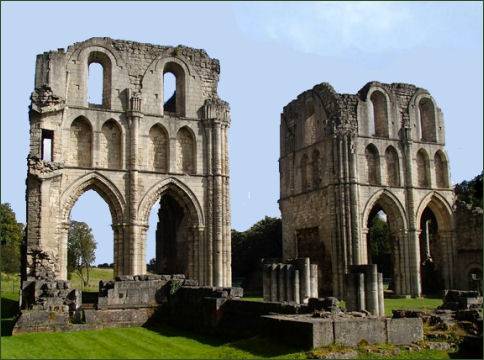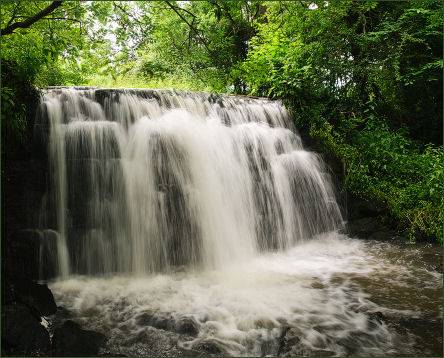Roche Abbey
OS grid reference:- SK 547 898
 The ruins of Roche Abbey, one of the less well-known Cistercian abbeys, are pleasantly situated beside Maltby Beck, to the south east of the town of Maltby, about 9 miles from Doncaster and 13 miles from Sheffield in South Yorkshire.
The ruins of Roche Abbey, one of the less well-known Cistercian abbeys, are pleasantly situated beside Maltby Beck, to the south east of the town of Maltby, about 9 miles from Doncaster and 13 miles from Sheffield in South Yorkshire.
The abbey was founded in 1147 by Richard de Busli, Lord of Tickhill, who was probably the great-nephew of the first Roger de Busli, the Norman builder of nearby Tickhill Castle, and Richard FitzTurgis. Its first monks came from the abbey at Newminster, in Northumberland and it was they who chose the beck side site. The abbey became a place of pilgrimage due to one of the rocks at Roche bearing a resemblance to the Cross.
Roche Abbey is situated on both banks of Maltby Beck. The site is protected by steep cliffs to the north, from which the name, meaning 'by the rocks' derives. The church, chapterhouse, cloister and the dorters and fraters of the monks and the lay brothers are on the north side of the beck, while the monks' dorter and frater extend over Maltby Beck on bridges, The infirmary, abbot's lodgings and kitchens, and other buildings stand on the south bank of the beck.
The control of the abbey was vested in the de Vesci family, lords of Rotherham, who in turn subfeuded the land to Richard FitzTurgis, lord of Wickersley. The abbey stood at the northern end of Sherwood Forest, and legend states that the outlaw Robin Hood heard Mass here. On the death of FitzTurgis', control of the abbey passed to his son Roger de Wickersley, and then eventually to a granddaughter Constantia, who married William de Livet. The abbey remained in the ownership of the Levett family until 1377, when rights to the abbey were purchased by Richard Barry, a London merchant.
 At the Dissolution of the Monasteries Roche Abbey was held by Henry Clifford, 2nd Earl of Cumberland, who was married to Lady Eleanor Brandon, daughter of Mary Tudor and Charles Brandon, Duke of Suffolk and the niece of King Henry VIII.
At the Dissolution of the Monasteries Roche Abbey was held by Henry Clifford, 2nd Earl of Cumberland, who was married to Lady Eleanor Brandon, daughter of Mary Tudor and Charles Brandon, Duke of Suffolk and the niece of King Henry VIII.
The abbey was surrendered to the crown on 23 June 1538. At that time there were 14 monks and an unknown number of novices at the abbey. Exhaustive inventories were taken of all the monks' possessions and livestock. The monks were turned out of their homes and the buildings ruined, lead was stripped from the roofs and timber removed leaving behind a scene of utter desolation.
A chronicle of the despoliation of Roche Abbey was written by Michael Sherbrook, a priest and rector of nearby Wickersley who personally observed the looting and wrote-. "It would have pitied any heart to see the tearing up of the lead, the plucking up of boards and throwing down of the rafters. And when the lead was torn off and cast down into the church and the tombs in the church were all broken."
The abbey stands in parkland designed by the landscape gardener Capability Brown. A cliff path walk provides access to a view across the abbey grounds. The best preserved structure is the gatehouse which dates to the fourteenth century.
Many of the buildings are low-standing but the walls of the church still stand at full height . Later additions to the buildings included a kitchen area and abbot's quarters, that were built on the other side of the beck. These quarters were accessed by a bridge which still stands. The destruction of Roche Abbey during the Dissolution of the Monasteries was recorded by an eyewitness at the time, this story is brought to life through interpetive panels and visitor displays.
The site is now in the care of English Heritage.
Abbeys and Churches of Yorkshire
Historic Buildings of Yorkshire
